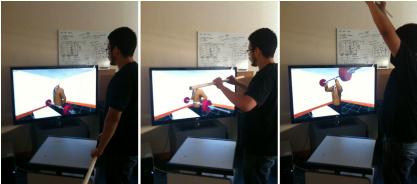Section: New Results
VR and Sports
Participants : Richard Kulpa [contact] , Benoit Bideau, Franck Multon.
Previous works in MimeTIC have shown the advantage of using VR to design and carry-out experiments on perception-action coupling in sports, especially for duels between two opponents. However the impact of using various technical solutions to carry-out this type of experiment in sports is not clear. Indeed immersion is performed by using interfaces to capture the motion/intention of the user and to deliver various multi-sensory feedbacks. These interfaces may affect the perception-action loop so that results obtained in VR cannot be systematically transferred to real practice.
Most of the applications in VR provide the user with visual feedbacks in which the avatar of the user can be more or less simplified (sometimes limited to a hand or the tools he his carrying). In first person view in caves the user generally does not need accurate avatars as he can perceive his real body but some authors have shown that the perception of distances is generally modified. Some authors have also demonstrated that first person view was less efficient that third person view with avatars when performing accurate tasks such as reaching objects in constrained environments. We proposed an experiment to evaluate which type of feedback was the most appropriate one for complex precision tasks, such as basketball free-throw. In basketball free-throw the user has to throw a ball into a small basket placed at over 4.5m far from him. Thus perception of distance is actually a key point in such a task. Beginners and experts carried-out a first experiment in real in order to measure their motion and performance in real situation. Then beginners were asked to perform free throws with a real ball in hands, but in three conditions in a Cave (Immersia): 1) first person view (see Figure 4 ), 2) third-person view with the visual feedback of the ball's position, and 3) third-person view the virtual ball and additional rings modeling the perfect trajectory for the ball to get in the basket. Results show that significant difference exist in ball speed between first person view condition compared to real condition whereas no difference exist in third-person view conditions. If we focus on successful throws only, ball speed in the last condition 3) was very similar to real condition whereas all the other VR conditions (1) and 2)) lead to significant differences compared to real situation. In all VR conditions the height of ball release was significantly higher in VR compared to real situation. These results show that VR conditions lead to adaptations in the way people perform such a precision task, especially for ball speed and height of ball release. However this difference is significantly higher with first person view and tends to zero in condition 3). Future works will tend to evaluate new conditions with avatars and complementary points of view (such as lateral and frontal views together as suggested by some authors). It will also be important to more clearly understand the problem of perception of distances in such an environment. This work has been performed in cooperation with University of Brassov in Romania [21] . This paper has received the best paper award of the ACM VRST 2014 Conference.
Another key feedback is the external forces associated with the task. In most sports applications such forces are strongly linked to performance. However delivering these forces in virtual environments is still a challenge as it required haptic devices that could affect the way the users perform the task (with a different grip compared to real situation and limitations in dynamic response of the device). Pseudohaptic has been introduced in the early 2000. It consists in using visual feedbacks to make people perceive the forces linked to a task. However this approach has not been tested for whole-body interaction. In collaboration with Hybrid team in Inria Rennes, we studied how the visual animation of a self-avatar could be artificially modified in real-time in order to generate different haptic perceptions. In our experimental setup participants could watch their self-avatar in a virtual environment in mirror mode. They could map their gestures on the self-animated avatar in real-time using a Kinect. The experimental task consisted in a weight lifting with virtual dumbbells that participants could manipulate by means of a tangible stick. We introduce three kinds of modification of the visual animation of the self-avatar: 1) an amplification (or reduction) of the user motion (change in C/D ratio), 2) a change in the dynamic profile of the motion (temporal animation), or 3) a change in the posture of the avatar (angle of inclination). An example is depicted in Figure 5 . Thus, to simulate the lifting of a ”heavy” dumbbell, the avatar animation was distorted in real-time using: an amplification of the user motion, a slower dynamics, and a larger angle of inclination of the avatar. We evaluated the potential of each technique using an ordering task with four different virtual weights. Our results show that the ordering task could be well achieved with every technique. The C/D ratio-based technique was found the most efficient. But participants globally appreciated all the different visual effects, and best results could be observed in the combination configuration [9] . Our results pave the way to the exploitation of such novel techniques in various VR applications such as for sport training, exercise games, or industrial training scenarios in single or collaborative mode.




